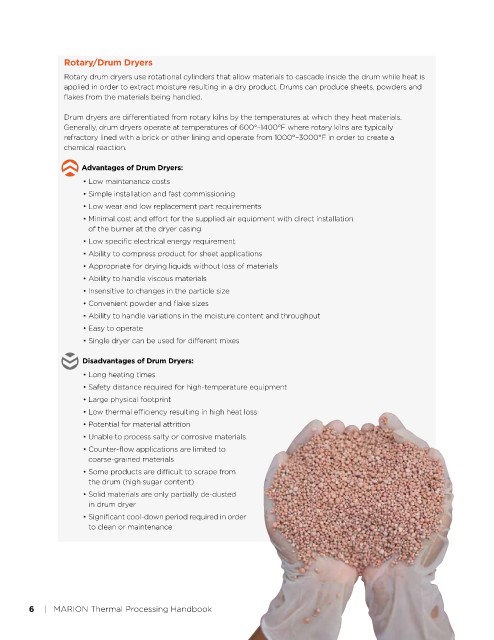Page 2708 - Flipbook_SolidDesignSoutheast2020
P. 2708
Rotary/Drum Dryers
Rotary drum dryers use rotational cylinders that allow materials to cascade inside the drum while heat is
applied in order to extract moisture resulting in a dry product. Drums can produce sheets, powders and
flakes from the materials being handled.
Drum dryers are differentiated from rotary kilns by the temperatures at which they heat materials.
Generally, drum dryers operate at temperatures of 600°–1400°F where rotary kilns are typically
refractory lined with a brick or other lining and operate from 1000°–3000°F in order to create a
chemical reaction.
Advantages of Drum Dryers:
• Low maintenance costs
• Simple installation and fast commissioning
• Low wear and low replacement part requirements
• Minimal cost and effort for the supplied air equipment with direct installation
of the burner at the dryer casing
• Low specific electrical energy requirement
• Ability to compress product for sheet applications
• Appropriate for drying liquids without loss of materials
• Ability to handle viscous materials
• Insensitive to changes in the particle size
• Convenient powder and flake sizes
• Ability to handle variations in the moisture content and throughput
• Easy to operate
• Single dryer can be used for different mixes
Disadvantages of Drum Dryers:
• Long heating times
• Safety distance required for high-temperature equipment
• Large physical footprint
• Low thermal efficiency resulting in high heat loss
• Potential for material attrition
• Unable to process salty or corrosive materials.
• Counter-flow applications are limited to
coarse-grained materials
• Some products are difficult to scrape from
the drum (high sugar content)
• Solid materials are only partially de-dusted
in drum dryer
• Significant cool-down period required in order
to clean or maintenance
6 | MARION Thermal Processing Handbook

